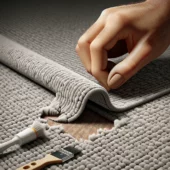Mold growth in damp areas of your home can pose significant health risks and damage to your property. Understanding how to prevent and manage mold is crucial for maintaining a healthy living environment. This article explores various strategies to prevent mold growth in your home, focusing on regular cleaning, maintenance, and the use of appropriate materials.
Key Takeaways
- Regular cleaning and prompt maintenance are essential to prevent mold growth.
- Use mold-resistant materials in construction and renovation to reduce future risks.
- Ensure proper ventilation and humidity control to inhibit mold development.
- Address moisture sources immediately to prevent the establishment of mold.
- Educate yourself and your household about the risks and prevention of mold to maintain a healthy home environment.
Understanding Mold Exposure

Mold Reactions: Who’s at Risk?
Mold exposure can irritate your eyes, skin, nose, throat, and lungs, affecting anyone, but particularly those with allergies or respiratory conditions. Prompt identification and remediation are crucial for maintaining a healthy living environment.
What Is Mold?
Mold is a type of fungus that grows in filaments and reproduces by forming spores that can travel through the air. The presence of mold is commonly detected by its musty odor and can be found both indoors and outdoors.
Where Do Molds Grow?
Molds thrive in moist, warm environments and can be found in places from damp basements to soggy drywall and carpets. Regular inspection and maintenance of these areas can prevent mold proliferation and the associated health risks.
Key Point: Regularly check and maintain areas prone to dampness to prevent mold growth.
Regular Cleaning and Maintenance

Promptly Address Water Leaks
Addressing water leaks promptly is crucial to prevent mold growth. Ensure to repair any leaks within 24-48 hours to keep the area dry and mold-free.
Drying Out Damp Areas
Actively drying out damp areas is essential. Use fans, dehumidifiers, or increased ventilation to accelerate the drying process and reduce the humidity levels that mold thrives in.
Routine Cleaning to Minimize Mold Growth
Regular cleaning is vital in minimizing mold growth. Focus on areas prone to dampness like bathrooms and kitchens. Use appropriate cleaning agents and ensure thorough ventilation during and after the cleaning to remove any moisture.
Proven strategies for deep-cleaning include vacuuming, spot cleaning, and ensuring all areas are dry and well-maintained to prevent mold.
Preventing Future Mold Growth

Improving Ventilation
Proper ventilation is crucial to prevent mold growth. Ensuring that air circulates freely can significantly reduce moisture levels, which are a primary cause of mold development.
Fixing Leaks Right Away
Addressing leaks immediately can prevent the conditions that allow mold to flourish. Keeping all plumbing and roofs in good repair cuts down on the moist environments that mold needs to grow.
Choosing Mold-Resistant Materials
When renovating or building, selecting mold-resistant materials can be a proactive step in mold prevention. These materials are designed to withstand moisture and prevent mold from taking hold.
By integrating these strategies into your home maintenance routine, you can effectively reduce the risk of mold growth and ensure a healthier living environment.
Improving Ventilation and Humidity Control

Installing Dehumidifiers
Installing dehumidifiers is a crucial step in controlling indoor humidity levels. By maintaining humidity between 30% and 50%, you can significantly reduce the potential for mold growth. Regular maintenance, such as cleaning the dehumidifier’s filter, ensures optimal performance.
Enhancing Air Circulation
Enhancing air circulation can be achieved through multiple strategies:
- Use ceiling fans to promote air movement.
- Open windows when outdoor humidity levels are low.
- Employ exhaust fans in high moisture areas like kitchens and bathrooms.
These actions help in maintaining a dry and mold-free environment.
Cleaning Ventilation Systems
Regular cleaning of ventilation systems is essential to prevent mold and ensure efficient operation. This includes:
- Checking and replacing filters regularly.
- Ensuring vents are not blocked by furniture or curtains.
- Having a professional inspect and clean ductwork annually.
Maintaining clean and unobstructed air pathways is vital for effective ventilation and humidity control.
Moisture and Mold Problems: Preventing and Solving Them in Your Home

Top Tips for Controlling Mold
Preventing mold in your home is easier than removing it. By addressing the moisture problems that can cause mold to grow, you are protecting yourself and your family from both health and property damage. Here are some practical steps to keep your home mold-free:
- Identify and fix sources of excess moisture, such as leaks or condensation.
- Ensure good air circulation and maintain low humidity levels inside your home.
- Regularly clean and dry areas prone to dampness, like basements and bathrooms.
Keeping your home dry is crucial in preventing mold growth and maintaining a healthy living environment.
8 Ways to Keep Your Home Healthy

Keep Your Home Dry
Maintaining a dry home is crucial to prevent mold growth and reduce allergens. Use dehumidifiers and ensure good ventilation to control humidity levels effectively.
Regular Cleaning and Maintenance
Regular cleaning and maintenance are essential for a healthy home environment. Address spills and leaks promptly to prevent moisture accumulation, which can lead to mold growth.
Use of Mold-Resistant Materials
When renovating or repairing, opt for mold-resistant materials. These materials can significantly reduce the risk of mold development, ensuring a healthier living space.
By integrating these strategies into your daily routine, you can significantly enhance the healthiness of your home environment.
Discover the top 8 ways to ensure your home remains a healthy sanctuary for you and your family. From green cleaning techniques to essential maintenance tips, our guide covers it all. Visit our website to explore more and keep your living space in top condition!
Conclusion
In conclusion, preventing mold growth in damp areas of your home is crucial for maintaining a healthy living environment. By implementing strategies such as improving ventilation, using dehumidifiers, and opting for mold-resistant materials, you can significantly reduce the risk of mold proliferation. Regular cleaning and maintenance, along with prompt attention to leaks and moisture, are essential practices that help keep mold at bay. Remember, taking proactive steps to control moisture and humidity is far more effective than addressing the aftermath of mold growth. By following these guidelines, you can ensure your home remains safe, clean, and mold-free.
Frequently Asked Questions
What is mold and why is it a concern in homes?
Mold is a type of fungus that can grow indoors and outdoors, thriving in damp, warm, and humid environments. It’s a concern in homes because it can cause structural damage and pose health risks, particularly to those with allergies or respiratory issues.
How can I prevent mold growth in my home?
Prevent mold growth by controlling humidity levels, ensuring proper ventilation, fixing leaks promptly, and using mold-resistant materials in areas prone to moisture.
What should I do if I find mold in my home?
If you find mold in your home, it’s important to remove it promptly. Small areas of mold can be cleaned with a mold-killing product, but larger infestations may require professional remediation.
Are there specific areas in the home where mold is more likely to grow?
Yes, mold commonly grows in areas with high moisture levels such as bathrooms, kitchens, basements, and around leaks in roofs, windows, or pipes.
Can cleaning carpets and upholstery help reduce mold?
Yes, regular cleaning of carpets and upholstery can help reduce mold by removing potential food sources for mold spores and maintaining a cleaner and drier environment.
What are the health risks associated with mold exposure?
Exposure to mold can lead to various health issues, especially for those with allergies or asthma. Symptoms can include sneezing, runny nose, red eyes, skin rash, and in severe cases, respiratory problems.



